Nanoimprint—Mo(o)re than Lithography
Definition
1. Introduction
- It imprints extremely thin polymer films, which result in residual layers of a few nm thickness and can be removed by anisotropic reactive ion etching [1].
2. Technology
2.1. NIL as a Toolbox for the High-Volume Manufacturing of Nanostructures
- The imprint, mold filling, or replication process is performed by pressing a stamp with a surface topography onto a material which undergoes displacement by squeeze flow (lateral flow-induced “push” due to the pressing of stamp protrusions into viscous material) or by capillary action (“pull” of material due to wetting and balance of surface energy) and can be molded. If the material is not liquid in its initial state, it must be made viscous. The air in the cavities of the stamp is either removed before molding, displaced to the side, or dissolved in the polymer.
- Demolding (de-embossing) is the detachment of the mold from the molded material. For this the material must become mechanically robust (solid) so that the surface topography is preserved during the following process steps. Given the mold’s primarily vertical sidewalls, demolding is based on overcoming the adhesion of the stamp surfaces to the polymer and a vertical sliding movement. Often, peeling effects can be exploited because stamps are often bendable and able to delaminate. Thus, during a dynamic process, the stamp is locally separated from the molded structures, enabling air to come in from the sides during demolding. Typically, the condition for NIL is that only vertical or positive slopes are allowed, enabling the demolding of fully hardened materials without undercuts (the so-called demolding constraint). If the stamp structures are flexible enough to allow demolding without damage (distortion or cohesive failure) or can be removed by dissolution, any kind of stamp geometry, e.g., grating ridges with slanted sidewalls and freeform surface topographies, can be demolded.
- Residual-layer etching is the homogeneous resist thinning that is required for window opening, i.e., the removal of polymer in the depressed areas of the resist before it can be used as a resist for pattern transfer, i.e., the conversion of the resist topography into a different material, by additive or subtractive transfer into or onto the underlying substrate. Since this is often achieved by anisotropic dry etching (sputtering) using oxygen plasma, it is often called breakthrough etching. In semiconductor processing, where very thin layers are used, it is also called descum process, used for the removal of resist residues.
2.2. Thermal NIL and UV-Assisted NIL
- In thermal imprint lithography (T-NIL), a stamp is pressed into thin thermoplastic film which is made viscous by heating; after the film conforms to the topography of the stamp, the film is cooled down until it is solid, and the stamp is detached. The main characteristic of such thermoplastic film is its glass transition temperature Tg, above which the film is transformed into the visco-elastic and then viscous state; thus, the thermomechanical properties of a film can be varied by heating and cooling. Typically, temperatures higher than Tg enable faster molding at lower viscosity, but since the entire stack of stamp, film, and substrate must often be heated and cooled within a thermocycle between the molding and demolding states, a large overhead must be considered. Viscosity is in the range of 103 to 107 Pa·s, and the filling of mold cavities can often be described by squeeze flow. A typical thermoplastic polymer is poly(methyl methacrylate) (PMMA), with a Tg of 100–120 °C, which can be imprinted at a temperature of 160–180 °C and demolded at 40–60 °C. Commercial polymers have been developed with better suitability for pattern transfer (higher etch resistance to reactive ion etching). They are typically solvent-based and can be spin-coated before patterning.
- UV imprint lithography (UV-NIL) uses a liquid pre-polymer with low viscosity which includes a photo initiator and a crosslinking agent. After filling, the material is chemically altered by exposing it, in most cases through the stamp, which, due to crosslinking, like negative photoresists, becomes insoluble. After hardening, the stamp can be detached and the structures demolded. Since viscosity is often in the range of 10−3 to 10−2 Pa·s, capillary filling is responsible for stamp filling, which allows for room-temperature molding at moderate pressure. Both spin-coating and ink-jetting are used to form the desired resist film (typically pre-polymers with solvent).
2.3. Hard and Soft Stamps
- Hard stamps exhibit the highest resolution and have long lifetime and low defectivity. They are made from silicon, fused silica (SiO2), metal, or diamond-like carbon. However, they are also prone to damage if imprinted on particles (e.g., ceramic particles released from mechanical elements due to mechanical friction and wear) which cannot be deformed, since they are often harder than the stamp material. Hard stamps are used for T-NIL because of the high pressure. For JFIL, high stiffness is required for overlay of a few nm. Even hard stamps, with their limited flexibility, can bend slightly to push out air and demolding by delamination [26].
- Soft stamps enable conformal contact to surface undulations and topographies at low pressure. They are often made from polymers or composed of different layers, e.g., by molding elastomeric or thermoplastic materials. This involves copying from hard masters. Resolution is dependent on the mechanical properties and can be tuned. Often a trade-off must be found, and hybrid solutions (high stiffness at the stamp protrusions and soft backbone) need to be employed. Because of its wide use, also in microcontact printing (µCP), processes using soft stamps are called “soft lithography” [27,28]. Today, most tool manufacturers use flexible stamps, with a hard structured surface layer and a flexible backbone. For specific NIL processes, such as substrate conformal imprint lithography (SCIL), inflatable molds which enable subsequent patterning from one side of an extended substrate to the other while squeezing out the air to one side have been developed. In addition, the demolding is performed by retracting the stamp continuously or stepwise from the substrate by peeling [29].
2.4. Full-Wafer Single Imprint or Step-and-Repeat (S&R) NIL
- Full-wafer single imprint employs a stamp with the same size as the substrate, e.g., a wafer-like substrate. Then the entire pattern of the stamp can be transferred in one step, like in mask aligners. Such large stamps can be produced by tiling smaller stamps together by recombination but also by using large-area processes such as interference lithography or DUV-PL (see Figure 4). Full-wafer single imprint has been developed for T-NIL and UV-NIL.
- Step-and-repeat (S&R) imprint processes are needed if a large-area stamp is not available or is too expensive or alignment cannot be assured over a large area. S&R NIL uses a stamp that is smaller than the substrate. By moving the stamp after imprinting to the adjacent area, with minimized stitching, the full surface can be sequentially covered with smaller, identical patterns until the entire wafer is fully covered with a regular array. S&R NIL has been developed for T-NIL and UV-NIL. In contrast to modern stepper-based PL, where a demagnified pattern of a mask is projected onto the substrate, S&R NIL requires high control of temperature or UV straylight, since imprinting over areas that have already been imprinted will result in a loss of structures or in a non-transfer of the pattern. Pick-and-place enables the use of individual stamps for different areas but is rarely used.
2.5. Continuous Processing
- In R2R-NIL the pattern of a rotating cylinder or a belt is transferred onto a flexible material such as polymeric (plastics) or metal films. Since the stamp is often made from a flat, flexible film that must be wrapped around a cylinder, the main challenge is to pattern the cylinder without a gap, which, otherwise, according to the application, can lead to seamlines, e.g., within long-distance optical elements. Often the term “roll embossing” is employed. R2R is better suited for large-area display devices but less compatible with thin resist layers and pattern transfer.
- R2P-NIL transfers the pattern of a roller stamp onto a flat substrate, and in P2R-NIL, a flat stamp is imprinted on continuous film. This needs to be performed in a discontinuous way using S&R. R2P is more appropriate for lithography-related processes and has already been adopted for wafer-level NIL, e.g., for AR/VR device HVM.
2.6. Hybrid Processes and Materials
- Combined nanoimprint and photolithography (CNP) is a process that was established to combine thermal NIL in a low-viscosity thermoplastic resist at moderate temperature and a consecutive UV-curing step that hardens the material by flood exposure. Obducat (Lund, Sweden, https://www.obducat.com/ (accessed on 7 July 2025)) uses a new stamp copy for each individual imprint, enabling the reduction in particle contamination of working stamps by incorporation using the so-called simultaneous thermal and UV (STU) imprint process and intermediate polymer stamps (IPSs). In the case where a stamp with an integrated absorber pattern is used, e.g., at the protruding elements of the stamp, crosslinking can be prohibited at the imprinted lower parts of the resist (where the light is blocked by the absorber), and the non-cured residual layer can be removed by chemical development [2,38,39].
- Reversal imprint (R-NIL) is a technique where a resist is patterned via NIL, released from the underlying surface, and attached to another surface or already imprinted resist structure by bonding. Thus, multiple layers can be stacked, or resist structures can be transferred to surfaces that cannot serve as the imprinted substrate (e.g., due to mechanical restrictions) [40]. Similar approaches are now established for planarization on non-flat surface patterns, e.g., by droplet-based dispensing.
- Combination of NIL, electron beam, DUV exposure, and localized thermal reflow, enabled by local variation in the thermoplastic properties of polymeric resists, creates surfaces with various patterns not achievable with PL alone, e.g., slopes instead of vertical sidewalls. This process is called TASTE (thermally activated selective topography equilibration) [41] and can be used to add molded surface patterns on polymeric 3D structures.
- Hybrid materials are, e.g., inorganic–organic hybrid polymers (e.g., UV-curable Ormocers and organically modified ceramics) that combine the advantages of polymers with, e.g., the hardness or the functionality of inorganic materials. They can be used for optical applications but also as stamp copies. Furthermore, titania (TiO2) and silicon carbide (SiC) nanoparticles can be patterned, either directly or within a polymer matrix, and sintered into high-NA lightguides for AR/VR applications [42,43].
- Stamps typically contain recessed and protruding features, i.e., flat areas with vertical sidewalls separating the two levels. Protrusions press materials downwards during imprint, thus resulting in lateral squeeze flow that enables the sinking of the stamp. The material flowing to the side fills the recessed areas that constitute the cavities in the stamps during imprint. Multi-level stamps contain several flat levels. Typically, the front protrusion must sit on larger protrusions. Such stamps enable the patterning of stepped resist structures and make it possible, e.g., to employ a self-aligned imprint lithography (SAIL) process, e.g., when the resist pattern is thinned down multiple times, each time followed by individual pattern transfer steps. SAIL was developed by HP for R2R processes for printed electronics. In the dual-damascene process, instead of a resist, the dielectric separating the wires of the interconnect layer of a chip is patterned, and the copper wires are created by electroplating [44,45].
- Directed self-assembly (DSA) of block copolymers (BCPs) is a way to enhance resolution of stamps or structures intended for pattern transfer. Although NIL has shown resolution down to single nanometer and even below, fabricating large-area stamps with sub-10 nm features is difficult and time-consuming. Thus, a combination of top-down, bottom-up processing was favored using DSA. Lower-resolution patterns are fabricated by top-down lithographic methods such as EBL, and BCPs with defined blocks of hydrophilic and hydrophobic segments that are smaller than these “rails” enable the generation of bottom-up patterns between these rails that are ordering the BCPs with high reproducibility and even the ability to heal defects in proximity. Other techniques pattern block polymers directly by using mechanical molding techniques, thus enabling the alignment of polymer chains and molecules [46,47]. If the blocks are made from different polymers, e.g., PMMA and polystyrene, their difference in etch resistance in reactive ion etching processes can be used to generate high-resolution resist patterns.
3. Tools and Materials
3.1. Full-Wafer Single Imprint and S&R Imprint Tools with Hard and Soft Elements
- Imprint machines or presses enable manual, semi-automated, or automated process cycles. NIL tools are mechanically “simpler” than micro-embossing tools for high-aspect-ratio microstructures (HARMSTs), which require high mechanical stiffness to ensure purely vertical movement during molding and mold separation, and vacuum to avoid trapped air. NIL presses require vertical flexibility, i.e., membrane-based solutions that enable conformal contact and peeling. However, like projection-based steppers, alignment requirements of sub-100 nm or even in the nm range make NIL presses mechanically challenging. This involves mechanisms for approaching; pressing; displacement, dissolution, or compaction of air; demolding; and handling. For T-NIL, due to high viscosity, a pressure of up to 10 MPa (100 bar/1’450 psi) for squeeze flow is required, for UV-NIL, and a low pressure of only 10 kPa (0.1 bar/1.5 psi) for capillary filling.
- Imprint stamps can be hard (silicon, fused silica, nickel, diamond, etc.) or soft (PDMS with different shore hardness) or combine hard and soft elements (e.g., hard PDMS on a soft backbone, or a soft topographical layer on a polymer film). A rigid stamp requires flat substrates, a dust-free environment, tilt control, and precise vertical movement while maintaining lateral alignment. An opaque and transparent stamp with silicon oxide on top can be coated with fluorinated silanes with excellent antisticking properties. There are a variety of processes for manufacturing stamps in silicon with specific topographies, e.g., high aspect ratio (HAR; ratio of height/width) and grating with slanted ridges.
- A resist is the intermediate material, used as a sacrificial layer, or a functional layer that is either directly created or transformed. It is defined by its chemical composition (e.g., chemistry of the polymer backbone and molecular weight) and by additives (photosensitive components, i.e., initiator, crosslinking agent, and solvent) and is characterized by its viscosity, etch resistance and selectivity with respect to the substrate, curing mechanism, and surface properties (good wetting during coating and good release and friction properties during demolding). PDMS, since it is gas-permeable, requires, as a stamp material, non-oxygen-inhibiting resists, i.e., which crosslink in the presence of oxygen. If non-gas-permeable materials such as fused silica are used as the stamp, they can imprint on oxygen-inhibiting resists, thus only hardening material in the gap between stamp surface and substrate, while squeezed-out material remains uncured. Further properties are refractive index, hardness, molecular weight, and glass transition, imprint (flow), and demolding temperatures.
3.2. Jet-and-Flash Imprint Lithography Tools
- JFIL uses a hard stamp (called die) with a patterned area of 26 × 33 mm2, which is adapted to the size of a PL exposure field in the industrial HVM of IC chips. It is made from a 6025 semi-standard, 6″ × 6″ × 0.25″ fused silica photomask template with a thinned-down central area that allows for flexibility and single contact in the center, enabling to squeeze air out to the sides.
- The resist is ink-jetted by drop-on-demand dispensing using a multi-nozzle print head. This allows for the rapid coating of the area that will be imprinted right afterwards and for density adaption according to the ratio of cavities to be filled. Alignment is performed in the liquid state, i.e., after the resist droplets are spread and merged.
- A micro-environment around the imprint area is created for local removal of dust particles, to reduce contamination by abrasion of ceramic bearings and filter particles from resists.
- Stamp copying is performed in a separate tool and requires a resist patterning process with consecutive pattern transfer such as reactive ion etching.
4. Applications
4.1. General
- Pattern transfer applications are those employing EBL and PL, because the imprinted structure is used as a temporary masking layer (“resist”), i.e., a sacrificial layer that is removed after the pattern transfer process is finished. Both IC chips and BPM belong to this category.
- Direct imprint applications are based on “resist-less” processes. The imprinted pattern adds functionality to the surface of a bulky device, which is the product. Often these are polymer devices or thin polymer films on top of a substrate.
4.2. Applications Based on Imprint on Resists for Pattern Transfer
4.2.1. IC-Chip Manufacturing
4.2.2. Non-IC-Chip Manufacturing
4.3. Applications Based on Imprint on Functional Materials
4.3.1. Surface-Patterned Polymer Devices
- Surface textures create effects that are based on topography by enlarging the surface and creating undercuts with large air pockets and directional patterns such as sawtooth structures. These include “gecko” surfaces with engineered adhesion, “sharkskin” surfaces that reduce drag in water, and antifog, anti-contamination, and anti-fouling applications. The so-called Lotus effect is a combination of micro- and nanostructures with a hydrophobic surface property that keeps the leaves of the Lotus plant free from contamination and dust. They reduce the contact area between particles and the surface and enlarges the water contact angle, which reduces the ability of water to wet surfaces. This enables the rolling of water droplets, which drags particles and fungi before they can infect the leaf.
- Diffractive gratings create antireflective or polarizing effects. The moth eye effect is achieved with arrays of pillars, which, due to their sub-wavelength period and tapered shape, create an adiabatic refractive index transition from the air to the eye that reduces reflectivity, without creating color effects. In contrast to this, a large interference grating arranged in 3D pillars, with small lateral domains, can be engineered by mimicking the “morpho blue” effect with structural rather than pigment-based coloring (“physical colors”). The blue color in butterfly wings is, in comparison to simple interference gratings, present in different directions. A new field is represented by metalenses, which enable the fabrication of “flat optics”, which enable a wide-angled field of view without a bulky set of stacked refractive lenses.
4.3.2. High-NA Waveguides for AR/VR Applications and Structural Colors
5. Conclusions and Prospects
Funding
Institutional Review Board Statement
Informed Consent Statement
Data Availability Statement
Acknowledgments
Conflicts of Interest
Abbreviations
| ASL | antisticking layer, a monomolecular layer of (perfluorinated) antiadhesive silanes |
| AR/VR | augmented/virtual reality, requiring goggles with integrated waveguides and gratings |
| BCP | block copolymer, with alternating segments of hydrophilic or hydrophobic properties |
| BPM | bit-patterned media |
| CNP | combined nanoimprint and photolithography, using stamps with integrated masks |
| DSA | directed self-assembly, enabling combination of top-down and bottom-up approaches |
| DUV | deep ultraviolet (248 nm or 193 nm and immersion 193 nm) |
| EBL | electron-beam lithography |
| EUV | extreme ultraviolet (13.5 nm), since 2019 used as wavelength for chip manufacturing |
| HVM | high-volume manufacturing |
| IRDS | International Roadmap for Devices and Systems (since 2016) |
| ITRS | International Technology Roadmap for Semiconductors (1993–2017), succeeded by IRDS |
| JFIL | jet-and-flash imprint lithography (Molecular Imprints Canon Nanotechnology) |
| LiGA | process sequence of lithography, electroforming, and molding (German acronym) |
| Moore’s law | Gordon Moore, CEO of Intel, noted in 1965 that the number of components per IC had been doubling every year. His prediction has held since 1975 and has become known as a law. It has been used in the semiconductor industry to guide long-term planning and to set targets for research and development, including resolution in lithography |
| µCP | microcontact printing, a soft lithography method |
| NIL | nanoimprint lithography |
| NNT | International Conference on Nanoimprint and Nanoprint Technology, since 2002 |
| PDMS | poly(dimethyl siloxane), silicone rubber used for soft lithography |
| PL | photolithography, using photons to pattern resists |
| R2R | roll-to-roll, continuous patterning technique for films |
| SAIL | self-aligned imprint lithography by Hewlett Packard HP |
| SAM | self-assembled monolayer, used for µCP |
| S&R | step-and-repeat, used for enlargement of surfaces using small stamps |
| SCIL | substrate conformal imprint lithography (by Philips) |
| STU | simultaneous thermal and UV imprint using intermediate polymer stamps (IPSs) |
| T-NIL | thermal NIL, also known as heat-assisted NIL or hot embossing |
| UV-NIL | UV-assisted NIL, using UV light for curing liquid resists |
References
- Heyderman, L.J.; Schift, H.; David, C.; Gobrecht, J.; Schweizer, T. Flow behaviour of thin polymer films used for hot embossing lithography. Microelectron. Eng. 2000, 54, 229–245. [Google Scholar] [CrossRef]
- Schift, H. Nanoimprint lithography: An old story in modern times? A review. J. Vac. Sci. Technol. B 2008, 26, 458–480. [Google Scholar] [CrossRef]
- Schift, H.; Kristensen, A. Nanoimprint lithography—Patterning resists using molding. In Handbook of Nanotechnology, 3rd ed.; Bhushan, B., Ed.; Springer: Berlin/Heidelberg, Germany, 2010; Chapter Part A/9; pp. 271–312. Available online: https://link.springer.com/chapter/10.1007/978-3-642-02525-9_9 (accessed on 7 July 2025).
- Schift, H.; Kristensen, A. Nanoimprint lithography—Patterning resists using molding. In Handbook of Nanotechnology, 4th ed.; Bhushan, B., Ed.; Springer: Berlin/Heidelberg, Germany, 2017; Chapter Part A/5; pp. 113–142. [Google Scholar]
- Resnick, D.; Schift, H. Nanoimprint lithography. In Microlithography—Science and Technology, 3rd ed.; Suzuki, K., Smith, B.W., Eds.; CRC Press: Boca Raton, FL, USA, 2020; Chapter 12; pp. 595–678. [Google Scholar]
- International Conference on Nanoimprint and Nanoprint (NNT). Available online: http://www.nntconf.org (accessed on 7 July 2025).
- Fujimori, S. Fine pattern fabrication by the molded mask method (nanoimprint lithography) in the 1970s. Jpn. J. Appl. Phys. 2009, 48, 06FH01. [Google Scholar] [CrossRef]
- Chou, S.Y.; Kraus, P.R.; Renstrom, P.J. Imprint of sub-25 nm vias and trenches in polymers. Appl. Phys. Lett. 1995, 67, 3114–3116. [Google Scholar] [CrossRef]
- Chou, S.Y.; Kraus, P.R.; Zhang, W.; Guo, L.; Zhuang, L. Sub-10 nm imprint lithography and applications. J. Vac. Sci. Technol. B 1997, 15, 2897–2903. [Google Scholar] [CrossRef]
- Haisma, J.; Verheijen, M.; van den Heuvel, K.; van den Berg, J. Mold-assisted lithography: A process for reliable pattern replication. J. Vac. Sci. Technol. B 1996, 14, 4124–4128. [Google Scholar] [CrossRef]
- Huang, G.T. 10 Emerging Technologies That Will Change the World. In MIT Technology Review; Technology Review Inc.: Cambridge, MA, USA, 2003; Available online: https://www.technologyreview.com/10-breakthrough-technologies/2003/ (accessed on 7 July 2025).
- Hua, F.; Sun, Y.; Gaur, A.; Meitl, M.A.; Bilhaut, L.; Rotkina, L.; Wang, J.; Geil, P.; Shim, M.; Rogers, J.A.; et al. Polymer imprint lithography with molecular-scale resolution. Nano Lett. 2004, 4, 2467–2471. [Google Scholar] [CrossRef]
- Tan, G.; Nozawa, Y.; Funabasama, T.; Koyama, K.; Mita, M.; Kaneko, S.; Komura, M.; Matsuda, A.; Yoshimoto, M. Atomic-scale thermal behavior of nanoimprinted 0.3 nm high step patterns on PMMA polymer sheets. Polym. J. 2016, 48, 225–227. [Google Scholar] [CrossRef]
- Chou, S.Y.; Keimel, C.; Gu, J. Ultrafast and direct imprint of nanostructures in silicon. Nature 2002, 417, 835–837. [Google Scholar] [CrossRef]
- Tormen, M.; Sovernigo, E.; Pozzato, A.; Pianigiani, M.; Tormen, M. Sub-100 μs nanoimprint lithography at wafer scale. Microelectron. Eng. 2015, 141, 21–26. [Google Scholar] [CrossRef]
- Schift, H. Nanoimprint lithography: 2D or not 2D? A review. Appl. Phys. A 2015, 121, 415–435. [Google Scholar] [CrossRef]
- Becker, E.W.; Ehrfeld, W.; Hagmann, P.; Maner, A.; Münchmeyer, D. Fabrication of microstructures with high aspect ratios and great structural heights by synchrotron radiation lithography, galvanoforming and plastic molding (LIGA process). Microelectron. Eng. 1986, 4, 35–56. [Google Scholar] [CrossRef]
- Gale, M.T. Replication techniques for diffractive optical elements. Microelectron. Eng. 1997, 34, 321–339. [Google Scholar] [CrossRef]
- Schift, H.; David, C.; Gabriel, M.; Gobrecht, J.; Heyderman, L.J.; Kaiser, W.; Köppel, S.; Scandella, L. Nanoreplication in polymers using hot embossing and injection molding. Microelectron. Eng. 2000, 53, 171–174. [Google Scholar] [CrossRef]
- Heckele, M.; Schomburg, W.K. Review on micro molding of thermoplastic polymers. J. Micromech. Microeng. 2004, 14, R1–R14. [Google Scholar] [CrossRef]
- Schift, H.; Urwyler, P.; Kristiansen, P.M.; Gobrecht, J. Nanoimprint lithography process chains for the fabrication of micro- and nanodevices. J. Micro/Nanolith. MEMS MOEMS 2014, 13, 031303. [Google Scholar] [CrossRef]
- Henke, W.; Schwalm, R.; Weiss, M.; Pelka, J. Diffraction effects in submicron contact or proximity printing. Microelectron. Eng. 1990, 10, 73–89. [Google Scholar] [CrossRef]
- Martin, O.J.F.; Piller, N.B.; Schmid, H.; Biebuyck, H.; Michel, B. Energy flow in light-coupling masks for lensless optical lithography. Opt. Express 1998, 3, 280–285. [Google Scholar] [CrossRef]
- Mack, C.A. (Lithoguru): Semiconductor Lithography (Photolithography)—The Basic Process 2006–2023. Available online: https://www.lithoguru.com/scientist/lithobasics.html (accessed on 7 July 2025).
- Achleitner, T.; Rimböck, J.; Vsetecka, L.; Schuster, P.; Thanner, C. Inkjet coating combined with nanoimprinting for complex 3D patterns with progressive height increase and low residual layer. Proc. SPIE 2024, 12956, 1295608. [Google Scholar]
- Colburn, M.; Stephen, C.; Johnson, S.C.; Stewart, M.D.; Damle, S.; Bailey, T.C.; Choi, B.; Wedlake, M.; Michaelson, T.B.; Sreenivasan, S.V.; et al. Step and flash imprint lithography: A new approach to high-resolution patterning. Proc. SPIE 1999, 3676, 379–389. [Google Scholar]
- Xia, Y.; Whitesides, G.M. Soft lithography. Angew. Chem. Int. 1998, 37, 550–575. [Google Scholar] [CrossRef]
- Michel, B.; Bernard, A.; Bietsch, A.; Delamarche, E.; Geissler, M.; Juncker, D.; Kind, H.; Renault, J.-P.; Rothuizen, H.; Schmid, H.; et al. Printing meets lithography: Soft approaches to high-resolution. IBM J. Res. Dev. 2001, 45, 697–719. [Google Scholar] [CrossRef]
- Ji, R.; Hornung, M.; Verschuuren, M.A.; van de Laar, R.; van Eekelen, J.; Plachetka, P.; Moeller, M.; Moormann, C. UV enhanced substrate conformal imprint lithography (UV-SCIL) technique for photonic crystals patterning in LED manufacturing. Microelectron. Eng. 2010, 87, 963–967. [Google Scholar] [CrossRef]
- Miller, M.; Schmid, G.; Doyle, G.; Thompson, E.; Resnick, D.J. Template replication for full wafer imprint lithography. Microelectron. Eng. 2007, 84, 885–890. [Google Scholar] [CrossRef]
- Emoto, K.; Sakai, F.; Sato, C.; Takabayashi, Y.; Nakano, H.; Takabayashi, T.; Kiyohito, Y.; Hattori, T.; Hiura, M.; Ando, T.; et al. Defectivity and particle reduction for mask life extension, and imprint mask replication for high-volume semiconductor manufacturing. J. Micro/Nanolithography MEMS MOEMS 2016, 15, 021006. [Google Scholar]
- Schift, H.; Saxer, S.; Park, S.; Padeste, C.; Pieles, U.; Gobrecht, J. Controlled co-evaporation of silanes for nanoimprint stamps. Nanotechnology 2005, 16, S171–S175. [Google Scholar] [CrossRef]
- Levola, T.; Laakkonen, P. Replicated slanted gratings with a high refractive index material for in and outcoupling of light. Opt. Express 2007, 15, 2067–2074. [Google Scholar] [CrossRef]
- Hirai, Y.; Kunitou, Y.; Yasuda, M. Study on the releasing process of tilted grating structure for AR glasses using nanoimprint. Proc. SPIE 2024, 12913, 129131K. [Google Scholar]
- van Schoot, J.; Schift, H. Next-generation lithography—An outlook on EUV projection and nanoimprint, Editorial of Topical Issue on Optical Nanostructuring. Adv. Opt. Technol. 2017, 6, 159–162. [Google Scholar] [CrossRef]
- Teyssedre, H.; Landis, S.; Thanner, C.; Laure, M.; Khan, J.; Bos, S.; Eibelhuber, M.; Chouiki, M.; May, M.; Brianceau, P.; et al. A full-process chain assessment for nanoimprint technology on 200-mm industrial platform. Adv. Opt. Technol. 2017, 6, 277–292. [Google Scholar] [CrossRef]
- Kooy, N.; Khairudin, M.; Pin, L.T.; Guan, O.S. A review of roll-to-roll nanoimprint lithography. Nanoscale Res. Lett. 2014, 9, 320. [Google Scholar] [CrossRef]
- Cheng, X.; Guo, L.J. A combined-nanoimprint-and-photolithography patterning technique. Microelectron. Eng. 2004, 3–4, 277–282. [Google Scholar] [CrossRef]
- Asif, M.H.; Graczyk, M.; Heidari, B.; Maximov, I. Comparison of UV-curable materials for high-resolution polymer nanoimprint stamps. Micro Nano Eng. 2022, 14, 100118. [Google Scholar] [CrossRef]
- Peng, C.; Pang, S.W. Hybrid mold reversal imprint for three-dimensional and selective patterning. J. Vac. Sci. Technol. B 2006, 24, 2968–2972. [Google Scholar] [CrossRef]
- Schleunitz, A.; Guzenko, V.A.; Messerschmidt, M.; Atasoy, H.; Kirchner, R.; Schift, H. Novel 3D micro- and nanofabrication method using thermally activated selective topography equilibration (TASTE) of polymers. Nano Converg. 2014, 1, 7. [Google Scholar] [CrossRef]
- Foerthner, M.; Rumler, M.; Stumpf, F.; Fader, R.; Rommel, M.; Frey, L.; Girschikofsky, M.; Belle, S.; Hellmann, R.; Klein, J.J. Hybrid polymers processed by substrate conformal imprint lithography for the fabrication of planar Bragg gratings. Appl. Phys. A 2016, 122, 240. [Google Scholar] [CrossRef]
- Einck, V.J.; Torfeh, M.; McClung, A.; Jung, D.E.; Mansouree, M.; Arbabi, A.; Watkins, J.J. Scalable nanoimprint lithography process for manufacturing visible metasurfaces composed of high aspect ratio TiO2 meta-atoms. ACS Photonics 2021, 8, 2400–2409. [Google Scholar] [CrossRef]
- Stewart, M.D.; Wetzel, J.T.; Schmid, G.M.; Palmieri, F.; Thompson, E.; Kim, E.K.; Wang, D.; Sotodeh, K.; Jen, K.; Johnson, S.C.; et al. Direct imprinting of dielectric materials for dual damascene processing. Proc. SPIE 2005, 5751, 210–218. [Google Scholar]
- Kim, H.-J.; Almanza-Workman, M.; Garcia, B.; Kwon, O.; Jeffrey, F.; Braymen, S.; Hauschildt, J.; Junge, K.; Larson, D.; Stieler, D.; et al. Roll-to-roll manufacturing of electronics on flexible substrates using self-aligned imprint lithography (SAIL). J. Soc. Inf. Disp. 2009, 17, 963–970. [Google Scholar] [CrossRef]
- Patel, K.C.; Ruiz, R.; Lille, J.; Wan, L.; Dobisz, E.; Gao, H.; Robertson, N.L.; Albrecht, T.R. Line-frequency doubling of directed self-assembly patterns for single-digit bit pattern media lithography. Proc. SPIE 2012, 8323, 83230U. [Google Scholar]
- Xiao, S.; Yang, X.; Steiner, P.; Hsu, Y.; Lee, K.; Wago, K.; Kuo, D. Servo-integrated patterned media by hybrid directed self-assembly. ACS Nano 2014, 8, 11854–11859. [Google Scholar] [CrossRef]
- Owen, J.H.G.; Fuchs, E.; Haq, M.; Santini, R.; Randall, J. (Zyvex Labs), Fabrication of atomically-precise nanoimprint masks by STM lithography. In Proceedings of the Electron Ion Photon Beam Technology and Nanofabrication (EIPBN), Savannah, GA, USA, 27–30 May 2025; Available online: https://eipbn.org/2025/ (accessed on 7 July 2025).
- Haatainen, T.; Ahopelto, J.; Gruetzner, G.; Finck, M.; Pfeiffer, K. Step & stamp imprint lithography using commercial flip chip bonder. Proc. SPIE 2000, 3997, 874–880. [Google Scholar]
- Colburn, M.; Suez, I.; Choi, B.J.; Meissl, M.; Bailey, T.; Sreenivasan, S.V.; Ekerdt, J.G.; Willson, C.G. Characterization and modeling of volumetric and mechanical properties for step and flash imprint lithography photopolymers. J. Vac. Sci. Technol. B 2001, 19, 2685–2689. [Google Scholar] [CrossRef]
- Sreenivasan, S.V. Nanoimprint lithography steppers for volume fabrication of leading-edge semiconductor integrated circuits. Microsyst. Nanoeng. 2017, 3, 17075. [Google Scholar] [CrossRef]
- Yamakawa, Y.; Ifuku, T.; Yonekawa, M.; Sato, K.; Saito, T.; Ito, T.; Yamamoto, K.; Hiura, M.; Takabayashi, Y.; Sakai, K. Nanoimprint lithography performance and applications. Proc. SPIE 2024, 13216, 281–291. [Google Scholar]
- Ifuku, T.; Yonekawa, M.; Nakagawa, K.; Sato, K.; Saito, T.; Aihara, S.; Ito, T.; Yamamoto, K.; Hiura, M.; Sakai, K.; et al. Nanoimprint lithography performance advances for new application spaces. Proc. SPIE 2024, 12956, 1295603. [Google Scholar]
- Ito, T.; Nishida, T.; Sakai, K.; Hiura, M.; Imamura, H.; Yamashita, K.; Fujimoto, M.; Asano, T.; Shirono, J.; Ito, Y.; et al. Enhanced nanoimprint lithography productivity using solvent-based resists. Proc. SPIE 2025, 13427, 1342709. [Google Scholar]
- Nanoimprint Lithography | Canon Global. Available online: https://global.canon/en/technology/nil-2023.html (accessed on 10 October 2025).
- Chen, Y. Applications of nanoimprint lithography/hot embossing: A review. Appl. Phys. A 2015, 121, 451–465. [Google Scholar] [CrossRef]
- Albrecht, T.R.; Arora, H.; Ayanoor-Vitikkate, V.; Beaujour, J.-M.; Bedau, D.; Berman, D.; Bogdanov, A.L.; Chapuis, Y.-A.; Cushen, J.; Dobisz, E.; et al. Bit-patterned magnetic recording: Theory, media fabrication, and recording performance. IEEE Trans. Magn. 2015, 51, 0800342. [Google Scholar] [CrossRef]
- Moon, S.-W.; Kim, J.; Park, C.; Kim, W.; Yang, Y.; Kim, J.; Lee, S.; Choi, M.; Sung, H.; Park, J.; et al. Wafer-scale manufacturing of near-infrared metalenses. Laser Photonics Rev. 2024, 18, 2300929. [Google Scholar] [CrossRef]
- Hauser, H.; Mellor, A.; Guttowski, A.; Wellens, C.; Benick, J.; Müller, C.; Hermle, M.; Bläsi, B. Diffractive backside structures via nanoimprint lithography. Energy Procedia 2012, 27, 337–342. [Google Scholar] [CrossRef]
- Mellor, A.; Hauser, H.; Wellens, C.; Benick, J.; Eisenlohr, J.; Peters, M.; Guttowski, A.; Tobías, I.; Martí, A.; Luque, A.; et al. Nanoimprinted diffraction gratings for crystalline silicon solar cells: Implementation, characterization and simulation. Opt. Express 2013, 21, A295. [Google Scholar] [CrossRef]
- Lee, Y.-C.; Yeh, S.-C.; Chou, Y.-Y.; Tsai, P.-J.; Pan, J.-W.; Chou, H.-M.; Hou, C.-H.; Chang, Y.-Y.; Chu, M.-S.; Wu, C.-H.; et al. High-efficiency InGaN-based LEDs grown on patterned sapphire substrates using nanoimprinting technology. Microelectron. Eng. 2013, 105, 86–90. [Google Scholar] [CrossRef]
- Schift, H. (Ed.) NaPa Library of Processes (NaPa-Consortium), 3rd ed.; Extended with the Results of the NaPANIL Project; J. Ahopelto, NaPa Consortium: Espoo, Finland, 2014; Available online: http://www.psi.ch/lmn/helmut-schift/ (accessed on 7 July 2025).
- Baraldi, L.; Kunz, R.E.; Meissner, J. High-precision molding of integrated optical structures. Proc. SPIE 1993, 1992, 21–29. [Google Scholar]
- Jaszewski, R.W.; Schift, H.; Gobrecht, J.; Smith, P. Hot embossing in polymers as a direct way to pattern resist. Microelectron. Eng. 1998, 41–42, 575–578. [Google Scholar] [CrossRef]
- Schift, H.; Jaszewski, R.W.; David, C.; Gobrecht, J. Nanostructuring of polymers and fabrication of interdigitated electrodes by hot embossing lithography. Microelectron. Eng. 1999, 46, 121–124. [Google Scholar] [CrossRef]
- Scheer, H.; Schulz, H. A contribution to the flow behavior of thin polymer films during hot embossing lithography. Microelectron. Eng. 2001, 56, 311–332. [Google Scholar] [CrossRef]
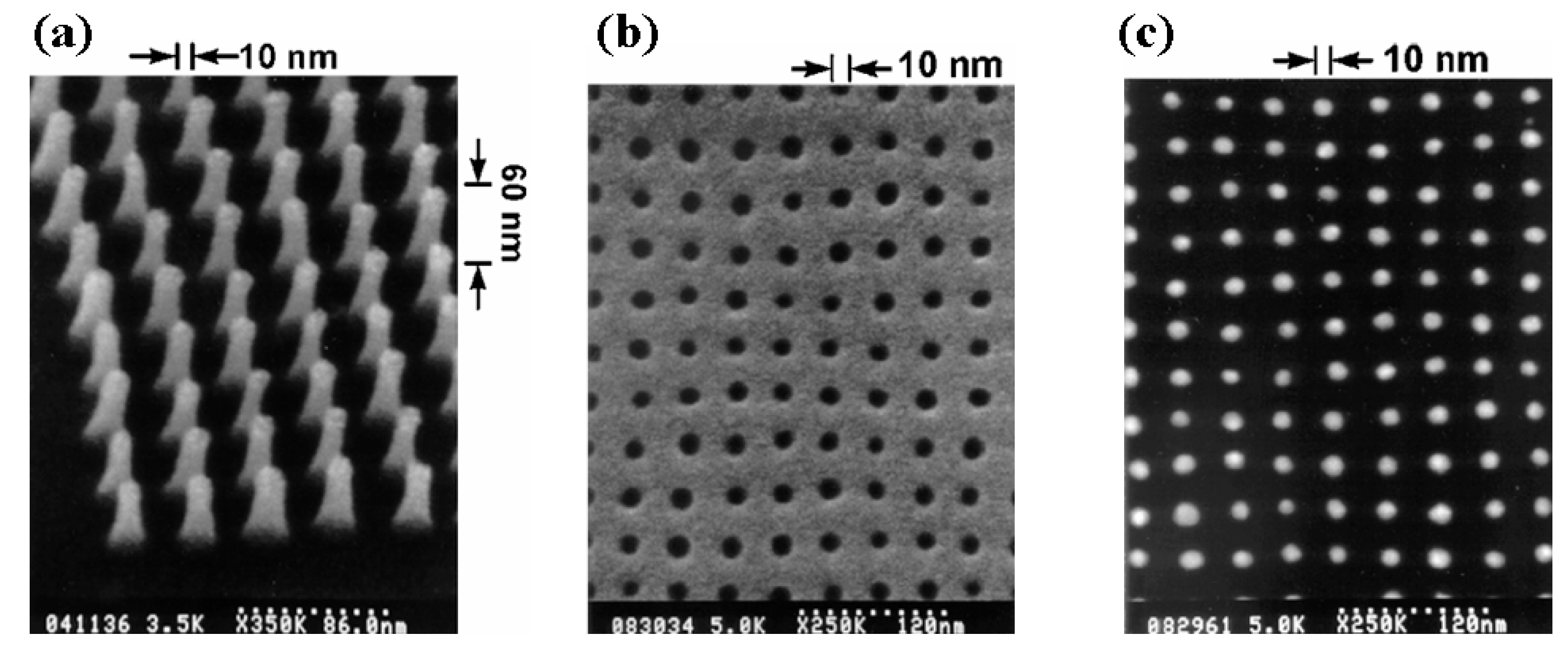
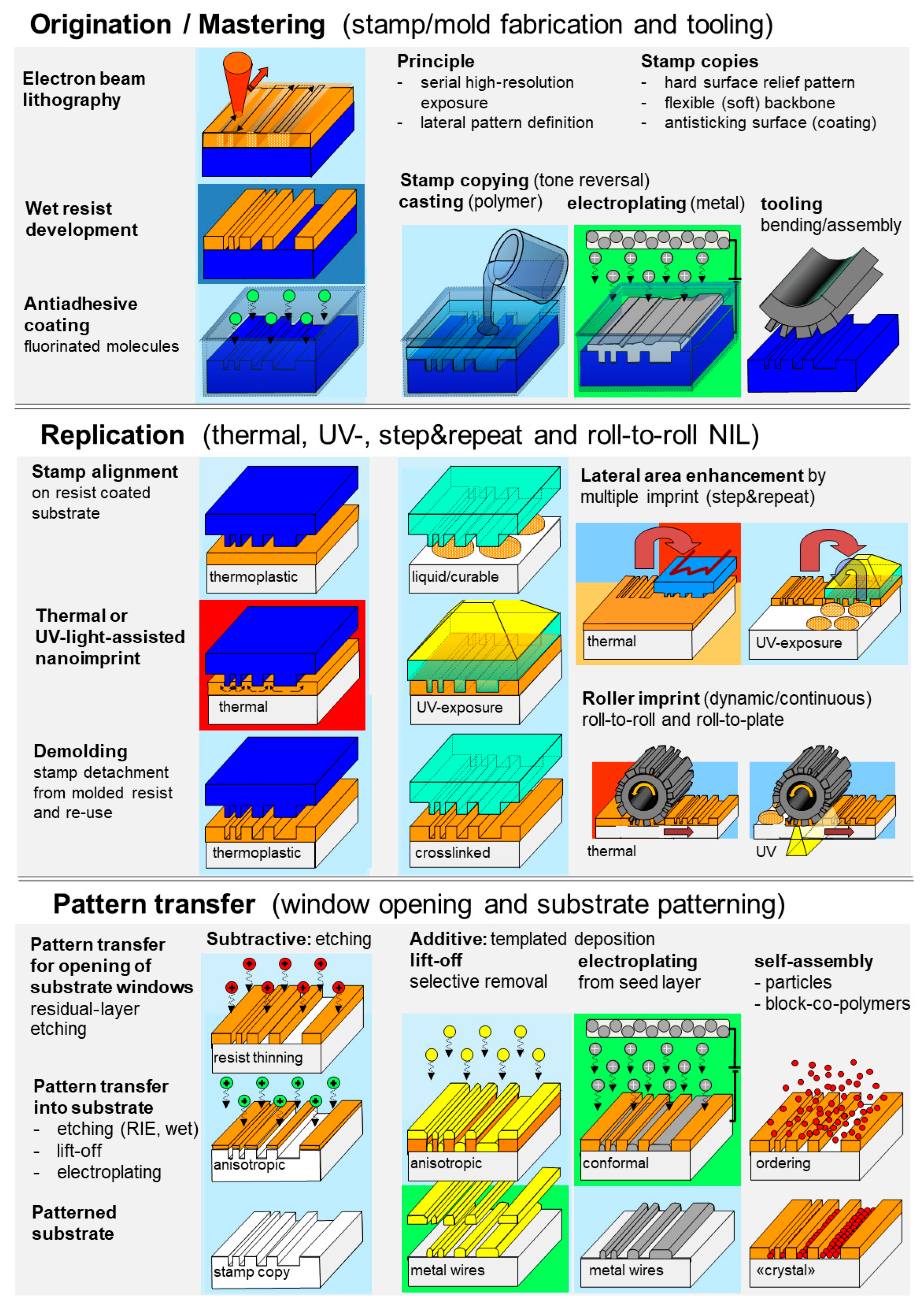
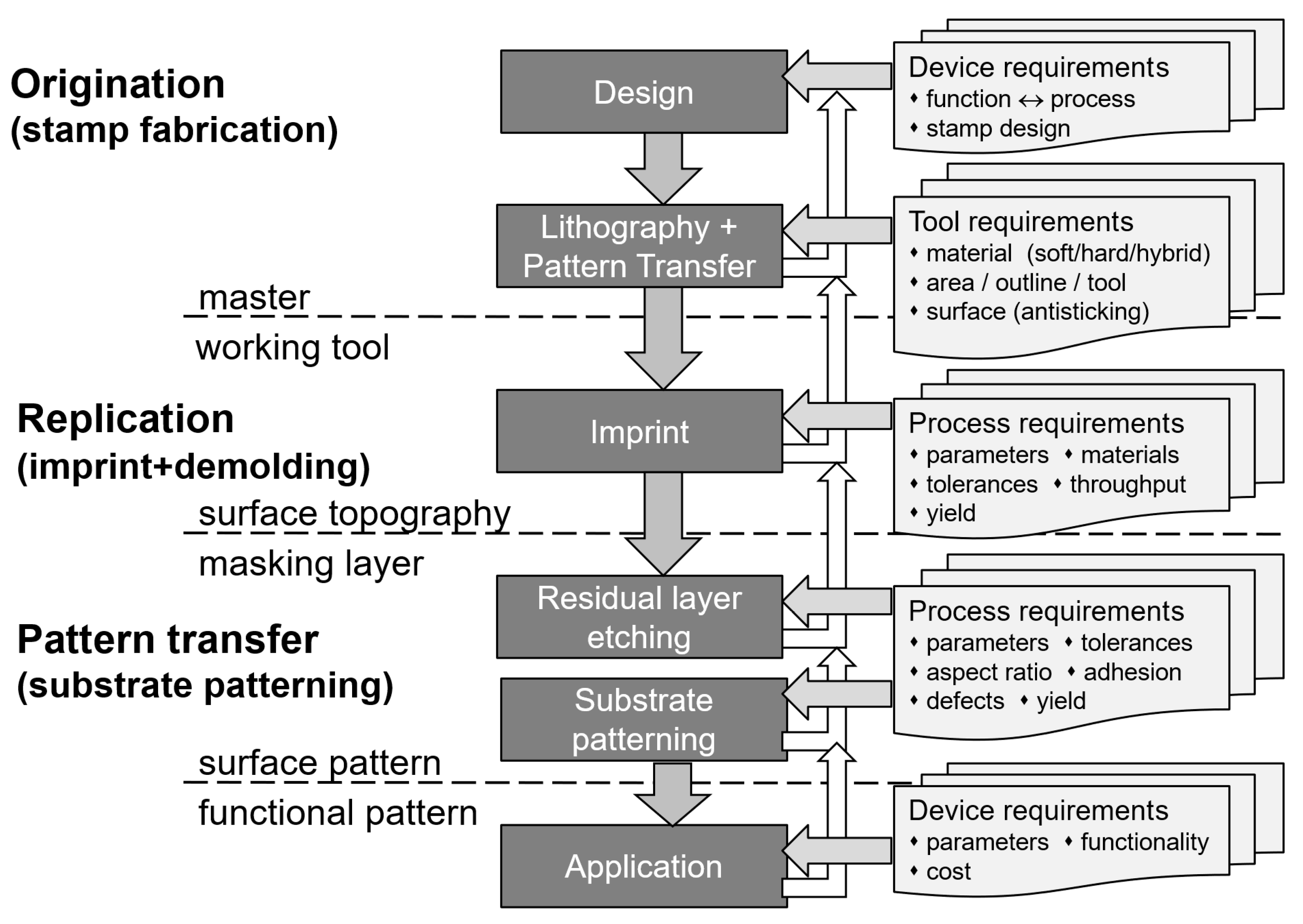
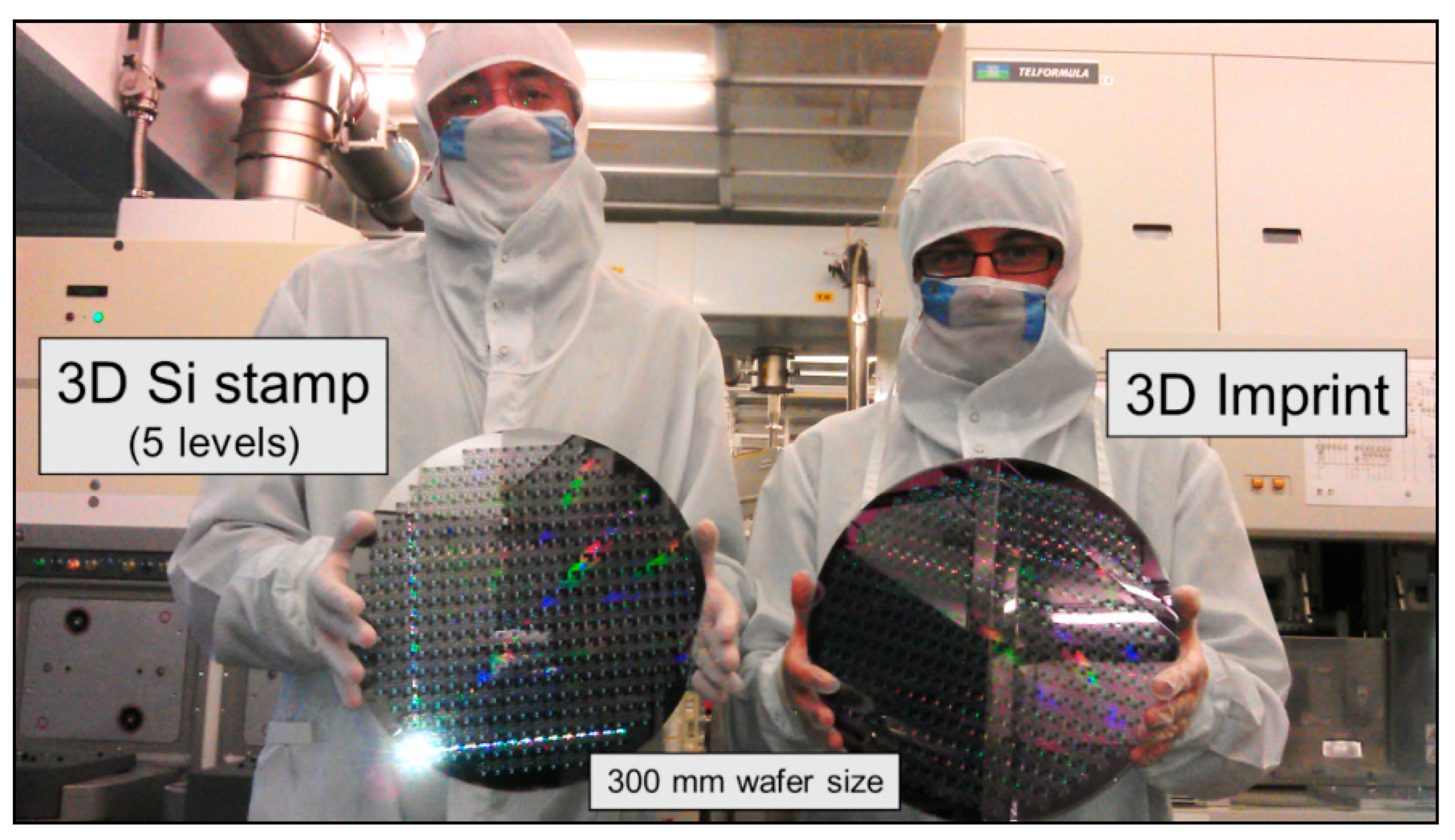
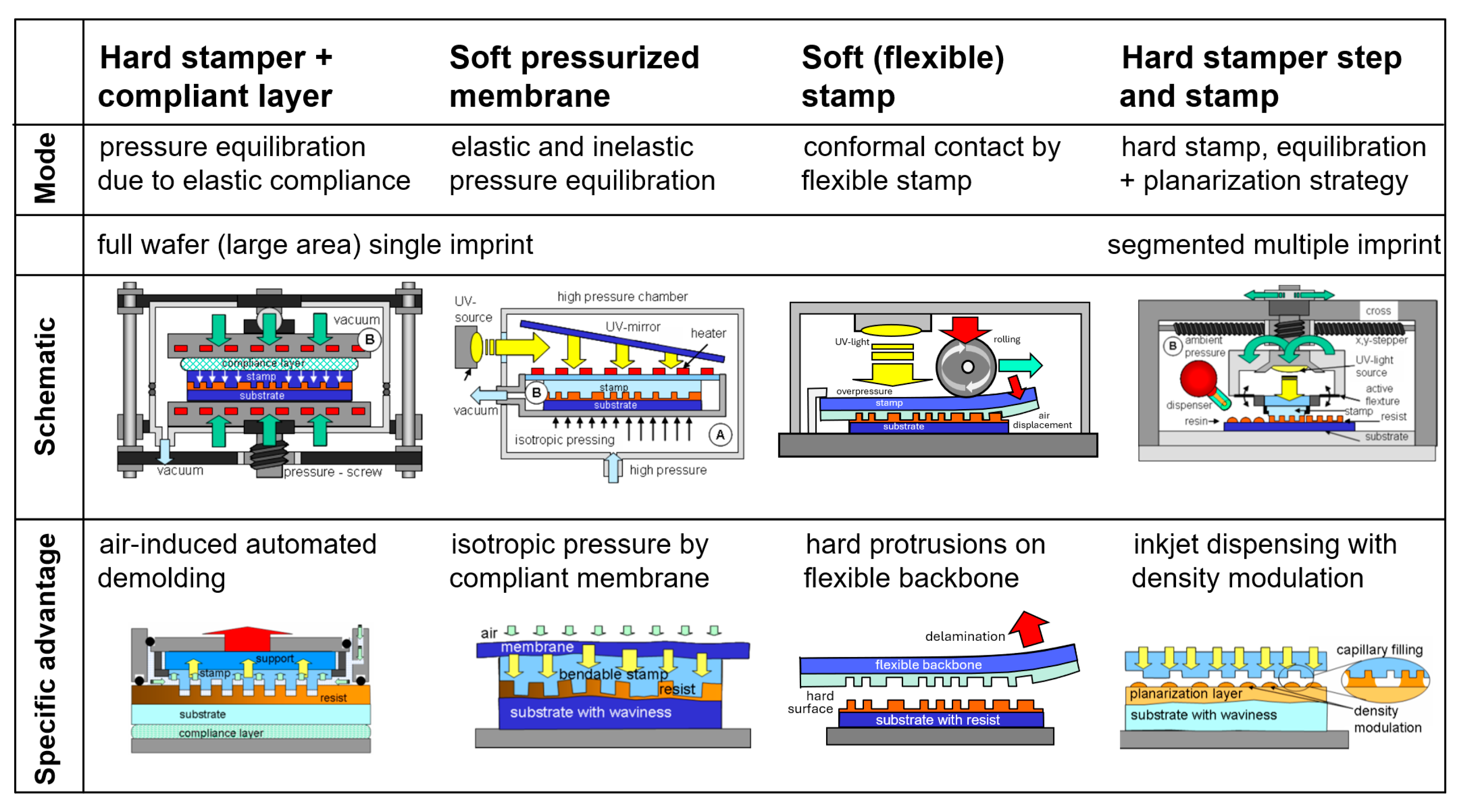

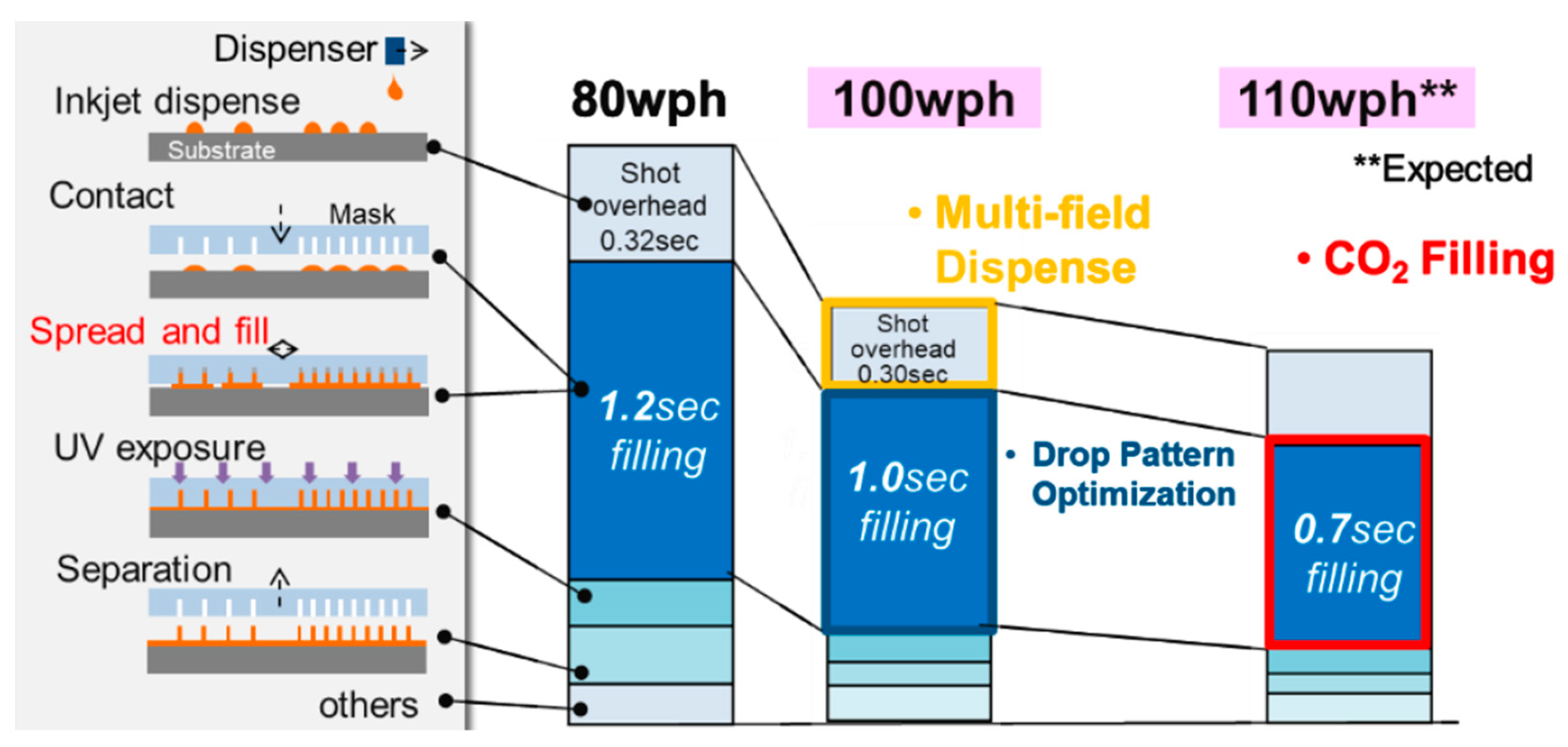

Disclaimer/Publisher’s Note: The statements, opinions and data contained in all publications are solely those of the individual author(s) and contributor(s) and not of MDPI and/or the editor(s). MDPI and/or the editor(s) disclaim responsibility for any injury to people or property resulting from any ideas, methods, instructions or products referred to in the content. |
© 2025 by the author. Licensee MDPI, Basel, Switzerland. This article is an open access article distributed under the terms and conditions of the Creative Commons Attribution (CC BY) license (https://creativecommons.org/licenses/by/4.0/).
Share and Cite
Schift, H. Nanoimprint—Mo(o)re than Lithography. Encyclopedia 2025, 5, 197. https://doi.org/10.3390/encyclopedia5040197
Schift H. Nanoimprint—Mo(o)re than Lithography. Encyclopedia. 2025; 5(4):197. https://doi.org/10.3390/encyclopedia5040197
Chicago/Turabian StyleSchift, Helmut. 2025. "Nanoimprint—Mo(o)re than Lithography" Encyclopedia 5, no. 4: 197. https://doi.org/10.3390/encyclopedia5040197
APA StyleSchift, H. (2025). Nanoimprint—Mo(o)re than Lithography. Encyclopedia, 5(4), 197. https://doi.org/10.3390/encyclopedia5040197









